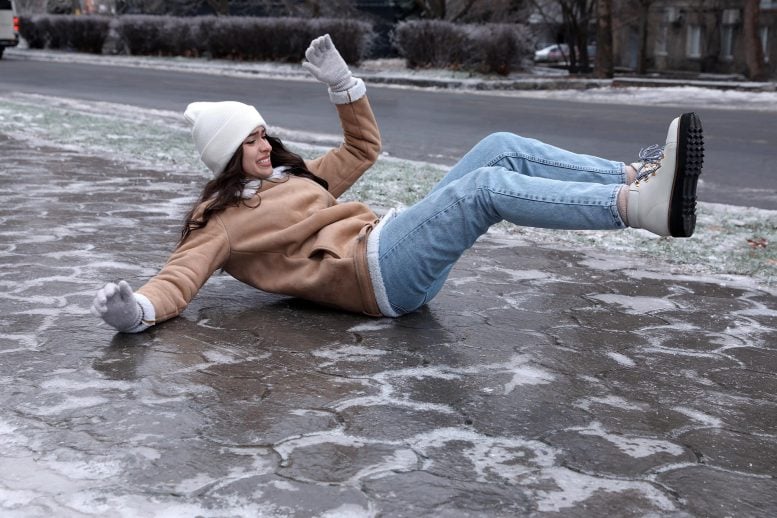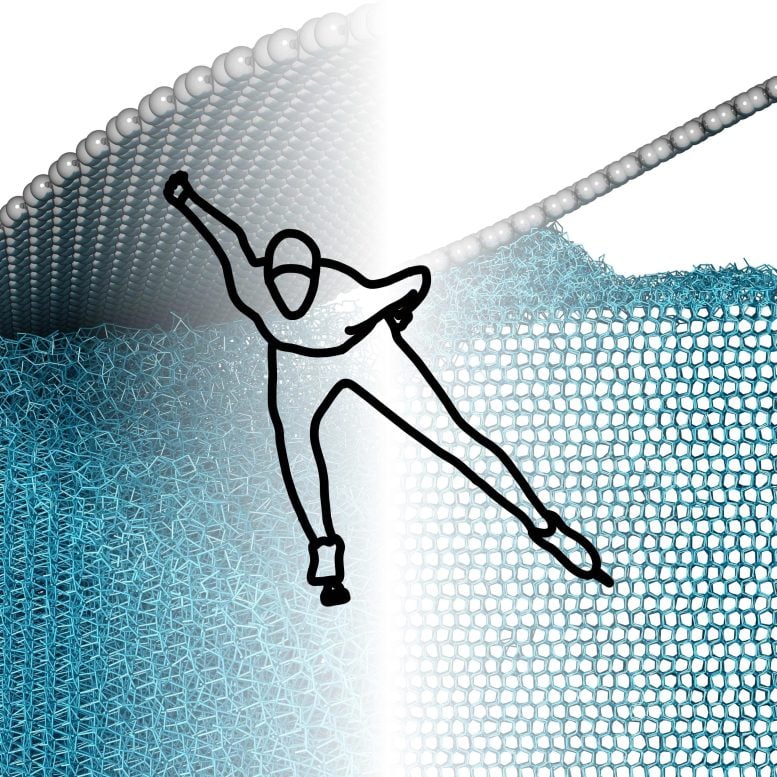
For nearly two centuries, scientists believed that ice becomes slippery because pressure or friction melts its surface. New research from Saarland University overturns this idea.
For more than a century, students around the world have been told that pressure and friction make ice melt. The familiar winter slip on a frozen sidewalk is often blamed on body weight pressing through the sole of your (still warm) shoe. New research from Saarland University indicates this view is incomplete, finding that slipperiness stems from interactions between molecular dipoles in the ice and those in the contacting surface, such as a shoe sole, rather than from pressure or friction.
The study by Professor Müser and colleagues Achraf Atila and Sergey Sukhomlinov challenges a model put forward nearly two hundred years ago by the brother of Lord Kelvin, James Thompson, who suggested that pressure and friction, along with temperature, cause ice to melt.
“It turns out that neither pressure nor friction plays a particularly significant part in forming the thin liquid layer on ice,” explains Martin Müser. Instead, computer simulations by the team reveal that molecular dipoles are the key drivers behind the formation of this slippery layer, which so often causes us to lose our footing in winter.
The Physics of Dipoles
But what exactly is a dipole? A molecular dipole arises when a molecule has regions of partial positive and partial negative charge, giving the molecule an overall polarity that points in a specific direction.
To get a better understanding of what is going on, it helps to know how ice is structured. Below zero degrees Celsius, water molecules (H₂O) arrange themselves into a highly ordered crystal lattice in which the molecules are all aligned neatly with one another creating a solid, crystalline structure.

When someone steps onto this orderly structure, it’s not the resulting pressure or friction of the shoe that disrupts the top layer of molecules, but the orientation of the dipoles in the shoe sole interacting with those in the ice. The previously well-ordered structure suddenly becomes disordered.
“In three dimensions, these dipole-dipole interactions become ‘frustrated,'” says Müser, referring to a concept in physics where competing forces prevent a system from achieving a fully ordered stable configuration.
At the microscopic level, the forces between the dipoles in the ice and those in the shoe sole material disrupt the orderly crystalline structure at the interface between ice and shoe, causing the ice to become disordered, amorphous, and ultimately liquid.
Rethinking Cold-Weather Physics
In addition to overturning nearly 200 years of accepted knowledge, the team‘s research also debunks another misconception. “Until now, it was assumed that skiing below –40°C is impossible because it’s simply too cold for a thin lubricating liquid film to form beneath the skis. That too, it turns out, is incorrect,” explains Professor Müser.
“Dipole interactions persist at extremely low temperatures. Remarkably, a liquid film still forms at the interface between ice and ski—even near absolute zero,” says Müser. However, at such low temperatures, the film is more viscous than honey. We’d hardly recognize it as water, and skiing on it would be practically impossible—but the film nevertheless exists.
For someone who is nursing an injury because they slipped and fell in winter, it hardly matters whether pressure, frictio,n or dipoles were to blame. But for physics, the distinction is crucial. The implications of this discovery by the Saarland research team are still unfolding, and the scientific community is taking notice.
Reference: “Cold Self-Lubrication of Sliding Ice” by Achraf Atila, Sergey V. Sukhomlinov and Martin H. Müser, 7 August 2025, Physical Review Letters.
DOI: 10.1103/1plj-7p4z
Never miss a breakthrough: Join the SciTechDaily newsletter.
12 Comments
I’ve theorized this from the age of 12, thinking that this was a known fact. Guess I’m a super genius.
Cant ski bbelow 40C ? Lmao! Maybe -40C? Regardless, its wrong. And suppose the sole material has no dipoles? Not all materials do. This review is very poor quality. As the original article is behind a pay wall and not readily available, it woud nice if you got the facts correct and complete.
Totally agree. They had to have made measurements with different polarity materials that apply minimal pressure while keeping the temperature of the system below freezing.
Nice Feynman nod in the title. I always thought it was odd the way he explained ice specifically in the whole “why” monologue he gave! The way he expressed it was more skeptical, his tone was different from the other phenomena too. It was like eh idk about this one bro, but here’s what “they say” about ice. My man knew something wasn’t right, probably for a while before saying that, but likely didnt have mental bandwidth to flesh it all the way out with everything else that busy mind latched onto. Genius intuition is a beautiful thing!
This … This is news today?!
Let that sink in
I tried to learn to snowboard in -28 c and the snow was sticky, perhaps this explains it..
No. This is not new. Scientists have known for a long time that ice wasn’t slippery because of pressure and friction.
The problem that I see with this theory is the fact that ice isn’t actually slippery unless you drag your sole across it, thereby causing friction. So for the theory to be coorect, you need to prove dipole ordering in the presence of friction and then eliminate the frivtion as causing it.
After all, there’s a reason why ice walking exist, a technique where you don’t slip on ice because you’re rolling your soles onto the ice and minimizing friction. So if friction is irrelevant, then what causes friction must also cause the dipolar ordering, so that you can eliminate friction as the cause for slipping.
But we now know the exact reason not just”it isnt that”
Next study, “Why is water wet “???
If this study is correct, ice would not slide on ice.
It most certainly does, so clearly these authors have more work to do.
Captain Scott of Antarctic fame ran an interesting but fatal experiment with icey dipoles. Assuming his sledge runners maintained whatever dipoles they had, and that snow ‘s dipoles are a constant, then pressure melting surely was involved in his experiment? Returning from the South Pole he and his manhauling mates were knocking off 20-26 miles a day until they got onto the Ross Ice Shelf. That was in February, when the sun does a low altitude, relative to the Earth, circuit around the sky. As I found, that low altitude February sun confers very little warmth in comparison with December and January. Scott found the temperatures in February and March to have dropped into the minus 30s and 40s Centigrade, unlike in summer when they were in the 10s. So that meant that the snow on the Ross Ice Shelf would have cooled off and would less amenable to pressure melting under their sledge’s runners, hence increasing friction thus reducing the manhauling miles to between 10 and 4 miles per day, instead of 20-25 miles per day, which was fatally slow as well as exhausting. Scott felt that they were dragging their sledge across sand as it was not running freely, as previously.
Or maybe the dipoles do something very interesting at a temperature of and below say, minus 25 degrees centigrade?